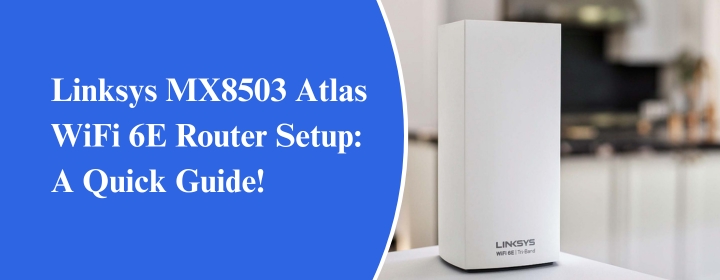
Linksys MX8503 Atlas WiFi 6E Router Setup: A Quick Guide!
If you’ve just bought the Linksys MX8503 Atlas WiFi 6E router, you’re holding one of the fastest and most future-ready mesh systems in the market. But like most premium routers, getting it running smoothly isn’t just about plugging it in — there’s a right way to install, configure, and place it so you get the blazing speed and coverage you paid for.
This setup guide is designed for the users to provide a simple and easy to follow walkthrough based on how to install the Linksys Atlas WiFi 6E router and solve any issues with your Linksys MX8503 Atlas WiFi 6E Router.
Let’s walk you through the Linksys MX8503 setup guide step-by-step.
What Is Linksys MX8503 Atlas WiFi 6E?
The Linksys Atlas MX8503 is a high-end tri-band WiFi 6E mesh system. What makes it stand out is the third band – the 6GHz spectrum. Unlike the older 2.4GHz and 5GHz, this new band is faster, less crowded, and built for next-gen devices. The system comes with Qualcomm’s advanced chipset, supports up to 270 devices, and is powered by Velop Intelligent Mesh tech for seamless roaming.
Each node covers around 3000 sq. ft., and the 3-pack setup can handle up to 9000 sq. ft. without drops or dead zones.
Before You Begin: What You’ll Need
Before you jump into how to install the Linksys Atlas WiFi 6E router, make sure you’ve got:
- Your ISP modem (already working)
- A smartphone with Bluetooth + internet access
- The Linksys App (download from Play Store/App Store)
- A Linksys cloud account (can be created during setup)
- The main router node and its power adapter
Optional but helpful:
- Ethernet cable (for faster initial sync)
- Laptop with browser access (in case app setup fails)
Step-by-Step: Linksys MX8503 Setup Guide
- Unbox and Place the Main Node
Take out one of the nodes — this will be your primary router. Plug it into the modem using the included Ethernet cable. Then connect the power cable and wait for the light to blink purple.
Tip: Place the main node out in the open, not inside cabinets. Better placement = better speed.
- Download the Linksys App and Sign In
Go to your app store and get the Linksys App. Open it and either sign in or create a new account. The app will automatically begin detecting your nearby Linksys device via Bluetooth.
Make sure your phone is close to the node during this process.
- Begin the Guided Setup
Once your router is detected:
- Choose your network name (SSID) and password
- Select “New Setup” if you don’t already have other Linksys nodes
- Let the app walk you through naming your WiFi and setting a secure password
- Choose the type of internet you’re using (most homes use DHCP or PPPoE)
- Wait as the node reboots and finalizes setup
If you get an error, unplug and restart both the modem and node.
- Add the Remaining Nodes (Mesh Setup)
Once the main node is active and online, the app will prompt you to add other nodes. These should be placed around halfway between the dead zones and the main router.
Plug them in, wait for blinking purple, then let the app detect and add them.
Pro Tip: Use wired backhaul if possible for better stability.
- Linksys WiFi 6E Router Configuration Settings
Now that the network is up, let’s tweak a few things:
- Parental Controls: Block sites, pause WiFi on certain devices
- Guest Network: Enable a separate network for guests
- Channel Optimization: Let the router pick the least crowded WiFi channels
- Firmware Update: Go to Settings > Network Administration > Update Firmware
- Device Prioritization: Prioritize traffic for gaming, video calls, etc.
All these are available through the Linksys App, and most take just one tap to configure.
Web-Based Access (Optional)
Sometimes, the app might not work or you may want deeper control. You can access the router through a browser:
- Connect your laptop to the new WiFi
- Open browser and go to: linksyssmartwifi.com or 192.168.1.1
- Login with your Linksys credentials
- You can manually configure security, firewall, MAC filtering, port forwarding, etc.
Troubleshooting Common Setup Issues
- Can’t Detect the Router in the App?
→ Reset the router by holding the reset button for 10 seconds. Retry with Bluetooth turned on. - Setup Freezes During Final Step?
→ Power cycle both the modem and router. Ensure the modem is fully online before starting again. - Secondary Nodes Won’t Connect?
→ Place them closer to the main node during setup. Once connected, you can move them farther. - Speed Seems Low After Setup?
→ Check for interference, run firmware update, and ensure you’re on the 6GHz band for compatible devices.
Why the Linksys MX8503 Is Worth It
You’re not just getting speed — you’re getting consistency, coverage, and capacity. If you’re in a large home or smart home setup with 30+ devices, this system makes sure everyone stays online, buffer-free.
The Linksys WiFi 6E router configuration also gives you flexibility — use the app for convenience or access deep settings via the web interface.
Final Thoughts
Setting up the Linksys MX8503 Atlas WiFi 6E system might feel overwhelming at first, especially if you’re upgrading from an older router. But once you follow this simple guide — from downloading the app to adjusting settings — it becomes clear how user-friendly this system actually is.
If you want high-speed, future-ready WiFi that doesn’t let you down when it matters most, the Linksys MX8503 delivers — and this guide ensures you’re getting the best out of it.
Frequently Asked Questions (FAQs)
- How can I install the Linksys Atlas WiFi 6E router without the app?
You can install it though the app. It is the easiest method. You can also log in via linksyssmartwifi.com using a browser to configure your router manually.
- How many devices can the MX8503 support?
Each node supports up to 65+ devices, so with 3 nodes, your mesh system easily handles over 150 devices with no drop in speed.
- How do I reset the Linksys MX8503 router?
Hold the Reset button on the router for 10 seconds using a pin. Wait for the LED to turn red, then restart the setup from scratch.
- Does the MX8503 support the old WiFi devices with old WiFi technologies?
Yes, it supports older WiFi technologies such as: “802.11 a/b/g/n/ac”, along with the latest WiFi 6 and WiFi 6E devices.
- What is the difference between the 5 GHz and 6 GHz bands?
The 6 GHz band offers less congestion and interference, resulting in faster speeds and more stable connections, especially in crowded homes.

